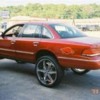I've been working on a friend's PW Gang Car on and off for a month. It had some problems requiring parts, so we order them and he stops over when they arrive and I put them in. But the problems continue. I've worked on quite a few of these (including my own) and have never run into a roadblock like this. Main problem initially......it ran slow and erratic. So here's a list of what I've done to it:
New brushes and springs
Installed brush plate ball bearing (it was missing)
Cleaned the commutator
Cleaned out old lube and relubed
Cleaned and resoldered all contacts
Replaced the field magnet
Tested the commutator segments and they checked out ok, but I did put another armature in there to test it....no difference
Here's what I'm left with.....it runs MUCH slower than my own and at about 1/2 the rpms. Mine however is modified. I fabricated a second pickup roller which eliminates the typical Gang Car herky jerk over switches and UCS tracks (I'll save that for another thread). The second roller, though, would not account for it's slow operation. It also runs smoother in reverse than forward. I'm thinking maybe that part is due to a worn brass gear. But that wouldn't account for the slow rpms. The only other thing I can think of to replace (other than the gear) is the brush plate. I'm out of ideas, so if anyone out there has some possible suggestions, I'm all ears.
Roger






